- FORUM
- PROJECTS
- ABOUT US
- RESOURCES
- CONTACT US
- FORUM
- PROJECTS
- ABOUT US
- RESOURCES
- CONTACT US
Rain Water Harvesting to augment ground water resources
Rain water harvesting is the technique of collection and storage of rain water at surface or in sub-surface aquifers, before it is lost as surface run-off. The augmented resource can be harvested in the time of need. Artificial recharge to ground water is a process by which the ground water reservoir is augmented at rate exceeding that under natural conditions of replenishment.
Rain Water Harvesting Need
To overcome the inadequacy of waters to meet our demands.To arrest decline in ground water levels.To enhance availability of ground water at specific place and time and utilize rain water for sustainable development.To increase infiltration of rain water in the subsoil which has decreased drastically in urban areas due to paving of open area.To improve ground water quality by dilution.To increase agriculture production.To improve ecology of the area by increase in vegetation cover, etc.
Rain Water Harvesting Advantages
Cost of recharge to sub-surface reservoir is lower than surface reservoirs.The aquifer serves as distribution system also.No land is wasted for storage purpose and no population displacement is involved.Ground water is not directly exposed to evaporation and pollution.Storing water underground is environment friendly.It increases the productivity of aquifer.It reduces flood hazards.Effects rise in ground water levels.Mitigates the effects of drought.Reduces soil erosion.
Design Considerations:
The important aspects to be looked into for designing a rainwater harvesting system to augment ground water resources are: -Hydrogeology of the area including nature and extent of aquifer, soil cover, topography, depth to water level and chemical quality of ground water.The availability of source water, one of the prime requisite for ground water recharge, basically assessed in terms of non-committed surplus monsoon runoff.Area contributing run off like area available, land use pattern, industrial,residential, green belt, paved areas, roof top area etc.Hydrometerological characters like rainfall duration, general pattern and intensity of rainfall.
Potential Areas
Where ground water levels are declining on regular basis.Where substantial amount of aquifer has been de-saturated.Where availability of ground water is inadequate in lean months.Where due to rapid urbanization, infiltration of rain water into subsoil has decreased drastically and recharging of ground water has diminished.
Methods & Techniques
The methods of ground water recharge mainly are:
Urban Areas
Roof Top Rain Water /Storm run off harvesting through
i) Recharge Pit
ii) Recharge Trench
iii) Tubewell
iv) Recharge Well
Rural Areas
Rain Water Harvesting through
i) Gully Plug
ii) Contour Bund
iii) Gabion Structure
iv) Percolation tank
v) Check Dam/ Cement Plug/ Nala Bund
vi) Recharge shaft
vii) Dugwell Recharge
viii) Ground Water Dams/Subsurface Dyke
Urban Areas
In urban areas, rain water available from roof tops of buildings, paved and unpaved areas goes waste. This water can be recharged to aquifer and can be utilized gainfully at the time of need. The rain water harvesting system needs to be designed in a way that it does not occupy large space for collection and recharge system. A few techniques of roof top rain water harvesting in urban areas are described below.
Roof Top Rain Water Harvesting Through Recharge Pit
In alluvial areas where permeable rocks are exposed on the land surface or at very shallow depth, roof top rain water harvesting can be done through recharge pits.The technique is suitable for buildings having a roof area of 100 sq.m. and are constructed for recharging the shallow aquifers.Recharge Pits may be of any shape and size and are generally constructed 1 to 2 m. wide and 2 to 3 . deep which are back filled with boulders (5-20 cm),gravels (5-10mm) and coarse sand (1.5- 2mm) in graded form. Boulders at the bottom, gravels in between and coarse sand at the top so that the silt content that will come with runoff will be deposited on the top of the coarse sand layer and can easily be removed. For smaller roof area, pit may be filled with broken bricks/ cobbles.A mesh should be provided at the roof so that leaves or any other solid waste / debris is prevented from entering the pit and a desilting /collection chamber may also be provided at the ground to arrest the flow of finer particles to the recharge pit.The top layer of sand should be cleaned periodically to maintain the recharge rate.By-pass arrangement be provided before the collection chamber to reject the first showers.
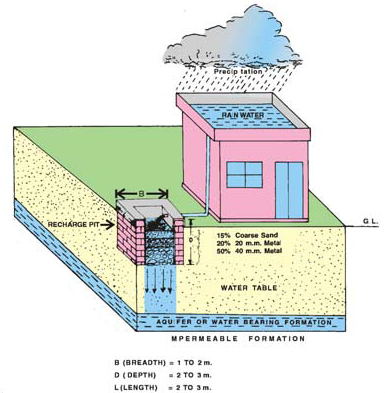
Roof Top Rain Water Harvesting Through Recharge Trench
Recharge trenches are suitable for buildings having roof area of 200-300 sq.m. and where permeable strata is available at shallow depths.Trench may be 0.5 to 1 m wide, 1 to 1.5m. deep and 10 to 20 m. long depending upon availability of water to be recharge.These are back filled with boulders (5-20cm), gravel (5-10 mm) and coarse sand (1.5-2 mm) in graded form – boulders at the bottom, gravel in between and coarse sand at the top so that the silt content that will come with runoff will be coarse sand at the top of the sand layer and can easily be removed.A mesh should be provided at the roof so that leaves or any other solid waste/debris is prevented from entering the trenches and a desilting/collection chamber may also be provided on ground to arrest the flow of finer particles to the trench.By-pass arrangement be provided before the collection chamber to reject the first showers.The top layer of sand should be cleaned periodically to maintain the recharge rate.
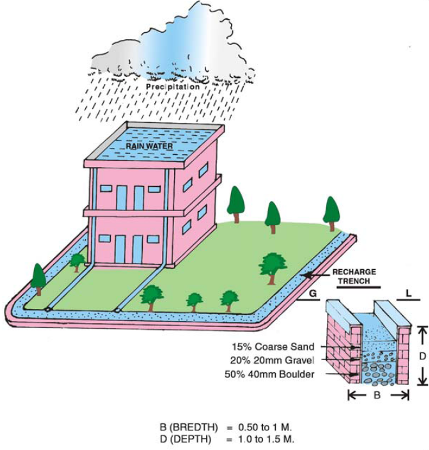
Roof Top Rain Water Harvesting Through Existing Tubewells
In areas where the shallow aquifers have dried up and existing tubewells are tapping deeper aquifer, roof to rain water harvesting through existing tubewell can be adopted to recharge the deeper aquifers.PVC pipes of 10 cm dia are connected to roof drains to collect rainwater. The first roof runoff is let off through the bottom of drainpipe. After closing the bottom pipe, the rainwater of subsequent rain showers is taken through a T to an online PVC filter. The filter may be provided before water enters the tubewells. The filter is 1 –1.2 m. in length and is made up of PVC pipe. It’s diameter should vary depending on the area of roof, 15 cm if roof area is less than 150 sq m and 20 cm if the roof area is more. The filter is provided with a reducer of 6.25 cm on both the sides. Filter is divided into three chambers by PVC screens so that filter material is not mixed up. The first chamber is filled up with gravel (6-10mm), middle chamber with pebbles (12-20 mm) and last chamber with bigger pebbles (20-40 mm).If the roof area is more, a filter pit may be provided. Rainwater from roofs is taken to collection/desilting chambers located on ground. These collection chambers are interconnected as well as connected to the filter pit through pipes having a slop of 1:15. The filter pit may vary in shape and size depending upon available runoff and are back-filled with graded material, boulder at the bottom, gravel in the middle and sand at the top with varying thickness (0.30- 0.50m) and may be separated by screen. The pit is divided into two chambers, filter material in one chamber and other chamber is kept empty to accommodate excess filtered water and to monitor the quality of filtered water. A connecting pipe with recharge well is provided at the bottom of the pit for recharging of filtered water through well.
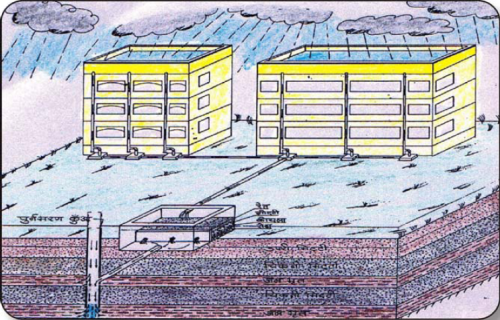
Roof Top Rain Water Harvesting Through Existing Tube-wells
Roof Top Rain Water Harvesting Through Trench With Recharge Well
In areas where the surface soil is impervious and large quantities of roof water or surface runoff is available within a very short period of heavy rainfall, the use of trench/ pits is made to store the water in a filter media and subsequently recharge to ground water through specially constructed recharge wells.This techniques is ideally suited for area where permeable horizon is within 3m below ground level.Recharge well of 100-300 diameter is constructed to a depth of at least 3 to 5 m below the water level. Based on the lithology of the area well assembly is designed with slotted pipe against the shallow and deeper aquifer.A lateral trench of 1.5 to 3m width and 10 to 30 m length, depending upon the availability of water is constructed with the recharge well in the centre.The number of recharge wells in the trench can be decided on the basis of water availability and local vertical permeability of the rocks.The trench is backfilled with boulders, gravels and coarse sand to act as a filter media for the recharge wells.If the aquifer is available at greater depth say more than 20 m, a shallow shaft of 2 to 5 m diameter and 3-5 metres deep may be constructed depending upon availability of runoff. Inside the shaft a recharge well of 100-300 mm dia is constructed for recharging the available water to the deeper aquifers. At the bottom of the shaft a filter media is provided to avoid choking of recharge well.
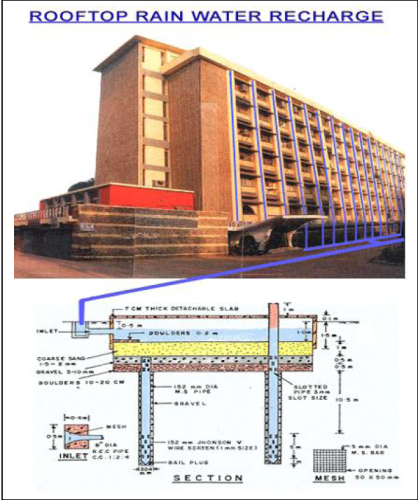
Rural Areas
In rural areas, rain water harvesting is taken up considering watershed as a unit. Surface spreading techniques are common since space for such systems is available in plenty and quantity of recharged water is also large. Following techniques may be adopted to save water going waste through slopes, rivers, rivulets and nalas.
Rain Water Harvesting Through Gully Plug
Gully Plugs are built using local stones, clay and bushes across small gullies and streams running down the hill slopes carrying drainage to tiny catchments during rainy season.Gully Plugs help in conservation of soil and moisture.The sites for gully plugs may be chosen whenever there is a local break in slope to permit accumulation of adequate water behind the bunds.
Rain Water Harvesting Through Contour Bund
Contour Bunds are effective methods to conserve soil moisture in watershed for long duration.These are suitable in low rain fall areas where monsoon run off can be impounded by constructing bunds on the sloping ground all along the contour of equal elevation.Flowing water is intercepted before it attains the erosive velocity by keeping suitable spacing between bunds.Spacing between two contour bunds depends on the slope the area as the permeability of the soil. Lesser the permeability of soil, the close should be spacing of bunds.Contour bunding is suitable on lands with moderate slopes without involving terracing.
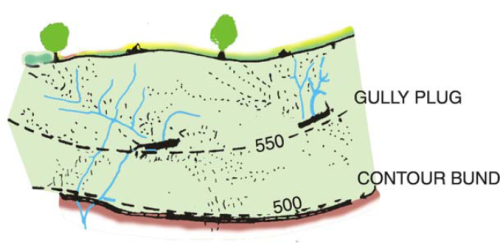
Rain Water Harvesting Through Gabion Structure
This is a kind of check dam commonly constructed across small streams to conserve stream flows with practically no submergence beyond stream course.A small bund across the stream is made by putting locally available boulders in a mesh of steel wires and anchored to the stream banks.The height of such structures is around 0.5 m and is normally used in the streams with width of less than 10 m.The excess water over flows this structure storing some water to serve as source of recharge. The silt content of stream water in due course is deposited in the interstices of the boulders in due course and with growth of vegetation, the bund becomes quite impermeable and helps in retaining surface water run off for sufficient time after rains to recharge the ground water body.
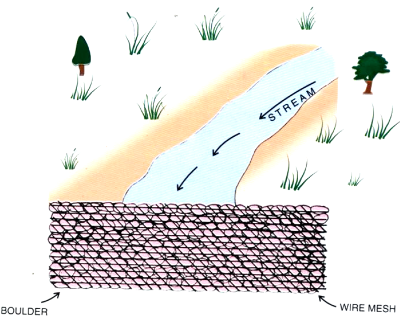
Rain Water Harvesting Through Gabion Structure
Rain Water Harvesting Through Percolation Tank
Percolation tank is an artificially created surface water body, submerging in its reservoir a highly permeable land so that surface runoff is made to percolate and recharge the ground water storage.Percolation tank should be constructed preferably on second to third order steams, located on highly fractured and weathered rocks, which have lateral continuity down stream.The recharge area down stream should have sufficient number of wells and cultivable land to benefit from the augmented ground water.The size of percolation tank should be governed by percolation capacity of strata in the tank bed. Normally percolation tanks are designed for storage capacity of 0.1 to 0.5 MCM. It is necessary to design the tank to provide a ponded water column generally between 3 & 4.5 m.The percolation tanks are mostly earthen dams with masonry structure only for spillway. The purpose of the percolation tanks is to recharge the ground water storage and hence seepage below the seat of the bed is permissible. For dams upto 4.5 m height, cut off trenches are not necessary and keying and benching between the dam seat and the natural ground is sufficient.
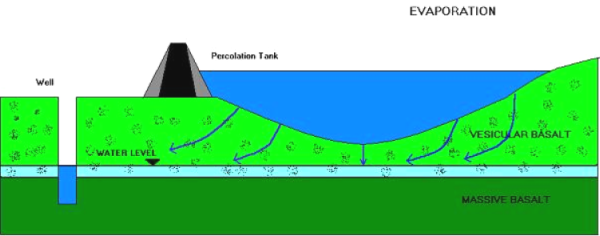
Rain Water Harvesting Through Percolation Tank
Rain Water Harvesting Through Check Dams / Cement Plugs / Nala Bunds
Check dams are constructed across small streams having gentle slope. The site selected should have sufficient thickness of permeable bed or weathered formation to facilitate recharge of stored water within short span of time.The water stored in these structures is mostly confined to stream course and the height is normally less than 2 m and excess water is allowed to flow over the wall. In order to avoid scouring from excess run off, water cushions are provided at downstream side.To harness the maximum run off in the stream, series of such check dams can be constructed to have recharge on regional scale.Clay filled cement bags arranged as a wall are also being successfully used as a barrier across small nalas. At places, shallow trench is excavated across the nala and asbestos sheets are put on two sides. The space between the rows of asbestos sheets across the nala is backfilled with clay. Thus a low cost check dam is created. On the upstream side clay filled cement bags can be stacked in a slope to provide stability to the structure.
Rain Water Harvesting Through Recharge Shaft
This is the most efficient and cost effective technique to recharge unconfined aquifer overlain by poorly permeable strata.Recharge shaft may be dug manually if the strata is of non-caving nature. The diameter of shaft is normally more than 2 m.The shaft should end in more permeable strata below the top impermeable strata. It may not touch water table.The unlined shaft should be backfilled, initially with boulders/ cobbles followed by gravel and coarse sand.In case of lined shaft the recharge water may be fed through a smaller conductor pipe reaching up to the filter pack.These recharge structures are very useful for village ponds where shallow clay layer impedes the infiltration of water to the aquifer.It is seen that in rainy season village tanks are fully filled up but water from these tanks does not percolate down due to siltation and tubewell and dugwells located nearby remains dried up. The water from village tanks get evaporated and is not available for the beneficial use.By constructing recharge shaft in tanks, surplus water can be recharged to ground water. Recharge shafts of 0.5 to 3 m. diameter and 10 to 15 m. deep are constructed depending upon availability of quantum of water. The top of shaft is kept above the tank bed level preferably at half of full supply level. These are back filled with boulders, gravels and coarse sand.In upper portion of 1 or 2 m depth, the brick masonry work is carried out for the stability of the structure.Through this technique all the accumulated water in village tank above 50% full supply level would be recharged to ground water. Sufficient water will continue to remain in tank for domestic use after recharge.
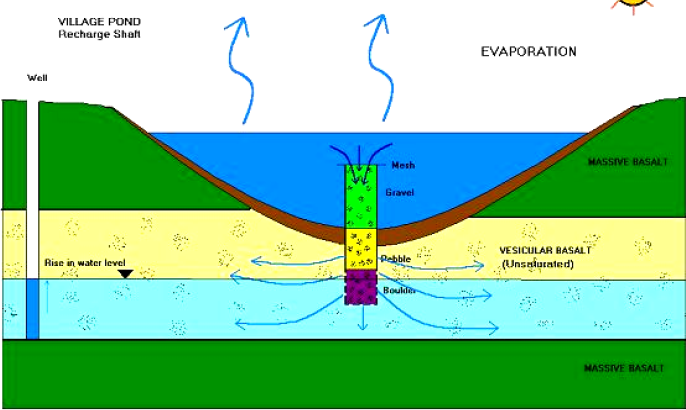
Rain Water Harvesting Through Percolation Tank
Rain Water Harvesting Through Dugwell Recharge
Existing and abandoned dug wells may be utilized as recharge structure after cleaning and desilting the same.The recharge water is guided through a pipe from desilting chamber to the bottom of well or below the water level to avoid scouring of bottom and entrapment of air bubbles in the aquifer.Recharge water should be silt free and for removing the silt contents, the runoff water should pass either through a desilting chamber or filter chamber.Periodic chlorination should be done for controlling the bacteriological contaminations.
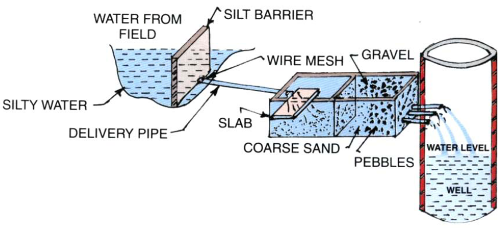
Rain Water Harvesting Through Dugwell Recharge
Ground Water Dams Or Sub-surface Dykes
Sub surface dyke or under-ground dam is a subsurface barrier across stream which retards the base flow and stores water upstream below ground surface. By doing so, the water levels in upstream part of ground water dam rises saturating otherwise dry part of aquifer.The site where sub-surface dyke is proposed should have shallow impervious layer with wide valley and narrow out let.After selection of suitable site, a trench of 1-2 m wide is dug across the breadth of stream down to impermeable bed. The trench may be filled with clay or brick/ concrete wall upto 0.5m. below the ground level.For ensuring total imperviousness, PVC sheets of 3000 PSI tearing strength at 400 to 600 gauge or low-density polythene film of 200 gauges can also be used to cover the cut out dyke faces.Since the water is stored within the aquifer, submergence of land can be avoided and land above the reservoir can be utilized even after the construction of the dam. No evaporation loss from the reservoir and no siltation in the reservoir takes place. The potential disaster like collapse of the dams can also be avoided.
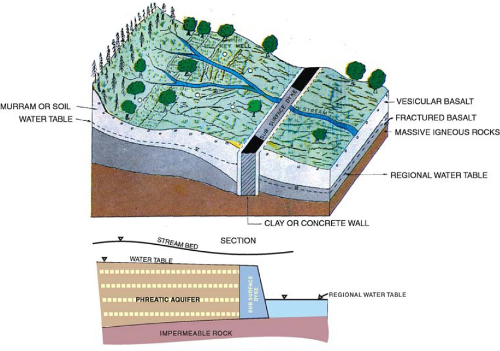
Ground Water Dams Or Sub-surface Dykes
Distribution Of Fresh Water On Earth
Of the total water on earth only 3% constitutes freshwater. Rest is saline water in the oceans.11% of the total freshwater on earth is groundwater available upto a depth of 800m which can be extracted for use.Mindless extraction and over exploitation of very small quantity of this precious nature resource has caused a rapid depletion and deterioration in its quantity and quality both.
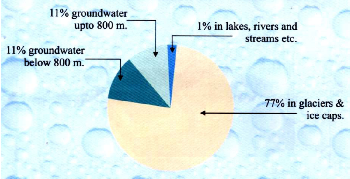
Distribution Of Fresh Water On Earth
ROOFTOP WATER HARVESTING
Trapping of the rain water that is incident on the rooftop and other hard surfaces for utilisation during the lean season and recharging of the ground water through simple filtration devices.
A 60 CM ANNUAL RAINFALL ON A 100 SQ. M. OF HARD SURFACE YIELDS A WATFR RUNOFF OF 40.000 LlTRES SUFFICIENT FOR A PERIOD OF 3 MONTHS FOR A FAMILY OF 5 PERSONS
Water Harvesting calculation
RAINWATER RUN-OFF : The portion of the rainfall that does not seep into the ground or evaporates Is available as rainwater run-off for harvesting.
RUN-OFF FACTOR (Rf) : The proportion of the rainfall incident in an unit area that will be available as surface run-off.
ANNUAL RAINWATER HARVESTING POTENTIAL (ARHP) : The amount of water that shall be available from the campus1 house1 Industrial complex for harvesting annually is termed as the Annual Rainwater Harvesting Potential.
CALCULATING ANNUAL RAINWATER HARVESTING POTENTIAL
ARHP = R x Rf x A
where, ARHP – Annual Rainwater Harvesting Potential (in cubic meters)
R – Annual rainfall (in mts.)
Rf – Run-off Co-efficient (%age)
A – Area (in sq. mts.)
Register & Download PDF for Educational Purposes Only

RAINWATER HARVESTING – A BASIC MANUAL FOR URBAN BUILT-UP AREAS by INTACH.pdf
Register as member and login to download attachment [pdf] by right-click the pdf link and Select “Save link as” use for Educational Purposes Only
Disclaimer
Information on this site is purely for education purpose. The materials used and displayed on the Sites, including text, photographs, graphics, illustrations and artwork, video, music and sound, and names, logos, IS Codes, are copyrighted items of respective owners. Front Desk is not responsible and liable for information shared above.
References
1) Website: www.cgwb.gov.in
Ministry Of Water Resources Central Ground Water Board Faridabad
2) RAINWATER HARVESTING – A BASIC MANUAL FOR URBAN BUILT-UP AREAS by INTACH